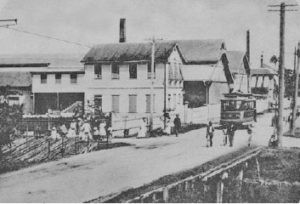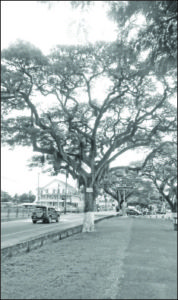
Have you ever looked at the towering trees on Main Street or around Georgetown and thought of when tree planting in the capital city began? Or thought of the history of the installation of street lights?
Gas lighting
According to the book “The story of Georgetown” by James Rodway, Stabroek was lighted in early times with lanterns fastened to wallaba posts. The oil used was probably train oil. In 1860 kerosene was introduced and iron lamp posts erected. Rodway also said in his book that gas lighting had been mentioned many times before it was seriously considered; it was proposed in 1838.
The Town Council back then seriously considered the introduction of gas in 1860. It was spoken of as likely to be a great improvement, but there were doubts as to whether people generally would adopt it. It was not to be supposed that the town lighting alone could support a gas company. However, several persons came forward with projects: the first being T. C. Jenkins, an American Consul. This offer was withdrawn after news of the impending war of secession.

Then came James Appleby, who offered to get up a company in London; his estimate was £4 4s. per street lamp, and 12 shillings per thousand feet for the public. The most serious offer was by S. R. Dickson, who, in 1861, proposed to establish the Demerara Gas Light Company. He asked for a lot of land for the works and offered to light 300 street lamps at $25 per annum and to supply light to private persons at $5 per 1,000 feet. He also stipulated that half the shares should be subscribed in the colony. The result of his action was a petition to the court and an ordinance dated August 2, 1862, which stated that the establishment of gas works in Georgetown would be of public advantage. The petitioners were S. R. Dickson, H. I. de Jonge, Jos. Kaufmann and Jas. Brady.
Nothing appears to have been actually done, and in 1864 a new ordinance was passed on the petition of A. W. Perot, F. A. R. Winter, J. S. Hill, J. Kaufmann and others. This also failed or at least did not get into working order in the time given by the ordinance and a new charter was granted in 1870. The preamble stated that the Demerara Company ordinance having ceased, A. W. Perot and G. H. Oliver, directors of that company, agreed with G. W. Harris, A. Williams, and others in England, to apply for a new ordinance to establish the Georgetown Gas Company.
At last, in March 1873 gas lighting became an accomplished fact. The Georgetown Gas Company did fairly well, and although there were complaints of the high price, still there was small ground for anything like dissatisfaction.
Electric lighting
Early in 1889, Julius Conrad, R. Allan, W. S. Turner and R. Dodds applied to the Town Council for a conditional promise to support an electric light company, and as they wanted a monopoly they were referred to the government. Their request for a monopoly for 30 years and for permission to use the streets were considered by the court and referred to the Town Council. Nothing was actually done until the following year, when a meeting was held at the house of Jacob Conrad on March 25, at which it was agreed to form a company.
On May 5 the town council agreed to refer a motion of Mr. Gibson that a test of 50 electric street lamps should be made to the lighting committee, which ultimately arranged for such a test. At the first general meeting of the company, on August 6, it was reported that 650 private lamps and 50 street lamps had been ordered and works expected to start on January 1, followed by lighting the greater part of High Street from Brickdam to Kingston.
On January 17, 1891, crowds of people filled the street to look at the new lights being turned on. Since that time, electric slowly, but surely, replaced gas, until the gas company was compelled to discontinue its operations and gas lighting came to an end.
Tree planting
The first attempt at tree planting in the streets was a short line of Fiddlewood trees, with here and there a bat-seed, Andirainermis, in Commerce Street. These were planted before 1870. A great impetus was given to ornamental planting by the laying out of the Promenade Gardens in 1853, when many trees and shrubs were imported from the Trinidad Botanical Gardens and elsewhere.
An early attempt to decorate Main Street was by a double line of Oleanders on either side of the canal, but these bushes never looked well due to them being damaged by the public.
An avenue of Mahogany trees in Le Repentir Cemetery dates from about 1870, and the coconut palms near the seawall were planted about the same time.
Rodway in his book stated, “All these were but poor attempts at street decoration, and we must thank the Botanic Gardens for almost everything [regarding trees] we have today.”
A sign on one of the trees, obliquely to Walter Roth Museum on Main Street, reads: “Rain Tree, scientific name: Samaneasaman. Interesting facts: Native to Tropical America, grows up to 50m tall and spreads as wide as 200 human steps, seeds are chewed for sore throat.” (Information from “The story of Georgetown” by James Rodway)



